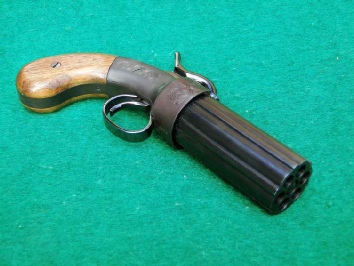Subject Guide

Mountain West
Malachite’s Big Hole

Above is an image of a reproduction Allen & Thurber pepperbox.
These pistols were generally small caliber, generally ranging from 28-36 caliber, though calibers ranged from 25 upwards to 58. Most have six barrels, though some have as few as three and extreme examples have as many as 18 (Winant page 9). Barrels were generally smoothbore, ranging in length from four to six inches. As can be expected, these guns are very front-heavy, and with their short barrels, effective at only very close range. Mark Twain in Roughing It describes the accuracy and effectiveness of the pepperbox:
George Bemis...wore in his belt an old original "Allen" revolver, such as irreverent people called a "pepperbox". ...To aim along the turning barrel and hit the thing aimed at was a feat which was probably never done with any "Allen" in the world. But George's was a reliable weapon, nevertheless, because as one of the stage-drivers afterward said, "If she didn't get what she went after, she would fetch something else." And so she did. She went after a deuce of spades nailed against a tree, once, and fetched a mule standing about thirty yards to the left of it. Bemis did not want the mule; but the owner came out with a double-barreled shotgun and persuaded him to buy it, anyhow.
I would characterize these as weapons of intimidation, rather than destruction because of their limited range and generally small caliber. In 1851, an assault to kill case was dismissed by the Mariposa California Justice of the Peace who ruled, “An Allen's pepperbox could not be construed as falling within the category of a dangerous weapon." (Silva 2003).
Most pepperboxes were constructed with nipples which were exposed to each other. As a result, these guns were notorious for their tendency to unintended chain firing of the barrels. According to J.M. George, “The consequence was that … the weapon would go off like a fire-cracker, the flash from one nipple firing the cap upon the next, and so on round the cylinder in a sputtering “feu-de-joie,” which was, most disconcerting for the user of the weapon but which must have been even more so for any unfortunate standing in the line of fire.” (Carl P Russell, 1957, Guns on the Early Frontiers, page 92.) Mark Twain in Roughing It also describes this tendency of the pepperbox to chain fire: “It was a cheerful weapon the "Allen." Sometimes all its six barrels would go off at once, and then there was no safe place in all the region round about, but behind it.”
In spite of the mechanical problems with the pepperbox revolving pistols, these guns became the most popular type of repeating pistol up to the Civil War.
These guns were taken into the west by trappers and traders to serve as a weapon of last resort. Ceran St. Vrain had a pair of Blunt and Syms pepperbox pistols with holsters which mounted on the pommel of a saddle. (von Damm, Museum of the Fur Trade Quarterly, 2007, Vol. 43, Number 1) Jim Baker, a mountain man and trapper is stated to have possessed a pepperbox (Nolie Mumie, 1931, The Life of Jim Baker, 1818-1898 page 79.) A pepperbox revolving pistol was found at the Rocky Crossing of the Big Sandy, on the route followed by pack trains to rendezvous on the Green River. Two of this gun’s barrels were still loaded at the time it was lost by it’s owner. (Carl P Russell, 1957, Guns on the Early Frontiers, page 92.)
For more information about pepperbox pistols see the following references:
Winant, Lewis, 1952, Pepperbox Firearms, Published by Greenberg, New York.
Silva, Lee A. When it comes to Popular Firearms used in the Early West, Pepperboxes are Nothing to Sneeze at. Wild West Magazine, June, 2003. Volume 16, Issue 1.
Back to the Top
Back to Pistols and Handguns